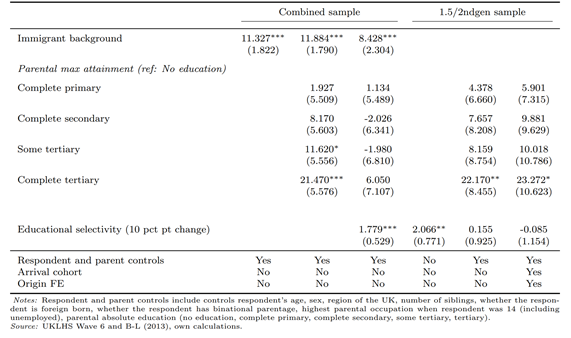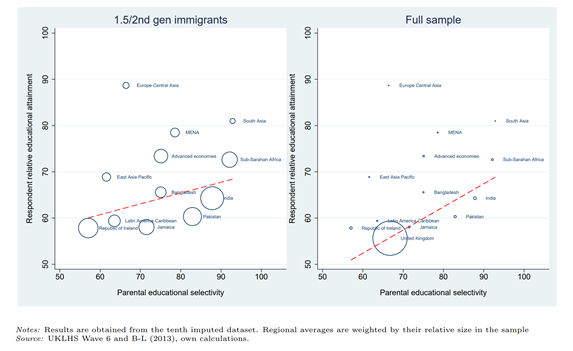Background and Motivation: Scholarship on the socioeconomic outcomes of immigrants and their children increasingly document the consequences of immigrant educational selectivity, in other words, the degree to which immigrants are more or less educated than “average” in terms of the sending country educational distribution. The immigrant selectivity hypothesis posits that the foreign born who stem from the upper end of the sending country educational distribution will possess (usually unobserved) beneficial resources and traits, which should positively influence the educational attainment of their children beyond the direct effects of their observed educational credentials (Feliciano 2020). US research finds that immigrant educational selectivity helps explain the “paradox” of the higher educational attainment of the children of immigrants relative to the children of US born natives (Feliciano and Lanuza 2017). Research for Europe is more equivocal: whereas Ichou (2014) finds a positive association between educational selection and second generation attainment in France, work on the Danish (Engzell 2019) and German (Dollmann and Weißmann 2020) contexts show that although positively selected immigrants pass on high aspirations to their children, their low levels of absolute education prevent them from supporting their children in competitive educational tracks. We seek to reconcile these conflicting findings in a new context – the UK. Like the US, the UK displays an “immigrant paradox” with higher attainment among the children of the foreign born. Like many other European countries, the British secondary school system is (historically) tracked at an early age and strongly stratified.
Research questions: This paper addresses asks: (a) can immigrant selectivity, or “contextual attainment,” help explain an immigrant paradox in education in the UK and (b) can immigrant selectivity explain variation in the educational attainment of the children of immigrants?
Data and Methods: We use the nationally representative panel study Understanding Society which includes a recent (2016) immigrant and ethnic minority boost. We examine three samples of adults age 25-55: (a) immigrant origin, with two foreign born parents (N=1,040), (b) third generation+, with two UK born parents (N=10,271), and (c) a sample combining both. Missing data is imputed with MI (20 datasets) and design weights used at both the imputation and estimation stage. Parental educational selectivity is measured using respondent reports of highest parental educational certifications, age and place of birth matched with corresponding information in the Barro-Lee (2013) dataset, which provides data on educational attainment distributions in 146 countries. We compute the percentage of people of the same country of origin, sex, and age group who have a lower level of educational attainment, plus half the percentage of people with the same level of education. This measure potentially runs from 0-100 and can be interpreted as the parents’ position in the sending country educational distribution [or the UK distribution for the 3rd gen+ sample]. Respondent’s relative education is measured with the same procedure with Barro-Lee data for the UK. Controls are entered sequentially as described in the tables below.
Main findings: In the first three columns of Table 1 we address our first research question, and models 1 and 2 confirm an immigrant paradox with higher relative attainment among the children of the foreign born. In model 3 we replicate the importance of immigrant selectivity in the British case: a ten point increase in parental educational selectivity is associated with approximately two point increase in respondent’s relative education, and explains about a third of the overall immigrant advantage. In the second three columns we examine our second research question with a similar set of regressions restricted to the children of immigrants only. We find that selectivity is positively associated with relative education without controls in model 1, but this coefficient becomes substantively and statistically insignificant with controls for absolute level of parental education, even turning negative after accounting for cohort of arrival and origin country. This result contradicts the immigrant selectivity hypothesis, and also presents an empirical puzzle, in that the positive association between educational selection and relative education we observe for the combined native and immigrant origin sample is not observed in the immigrant origin only sample.
Preliminary Conclusions: One potential explanation is Simpson’s paradox: the relatively lower overall attainment of the large 3rd generation+ population is an outlier that distorts the fitted regression line in the combined sample (see figure 1 below). We are currently exploring other explanations, including potential moderating and mediating effects of the selectivity – attainment association.
REFERENCES
Barro, Robert J., and Jong Wha Lee. 2013. “A New Data Set of Educational Attainment in the World, 1950–2010.” Journal of Development Economics 104:184–98. doi: 10.1016/j.jdeveco.2012.10.001.
Dollmann, Jörg, and Markus Weißmann. 2020. “The Story after Immigrants’ Ambitious Educational Choices: Real Improvement or Back to Square One?” European Sociological Review 36(1):32–47. doi: 10.1093/esr/jcz042.
Engzell, Per. 2019. “Aspiration Squeeze: The Struggle of Children to Positively Selected Immigrants.” Sociology of Education 92(1):83–103.
Feliciano, Cynthia. 2020. “Immigrant Selectivity Effects on Health, Labor Market, and Educational Outcomes.” Annual Review of Sociology 46(1):315–34. doi: 10.1146/annurev-soc-121919-054639.
Feliciano, Cynthia, and Yader R. Lanuza. 2017. “An Immigrant Paradox? Contextual Attainment and Intergenerational Educational Mobility.” American Sociological Review 82(1):211–41. doi: 10.1177/0003122416684777.
Ichou, Mathieu. 2014. “Who They Were There: Immigrants’ Educational Selectivity and Their Children’s Educational Attainment.” European Sociological Review jcu071.


